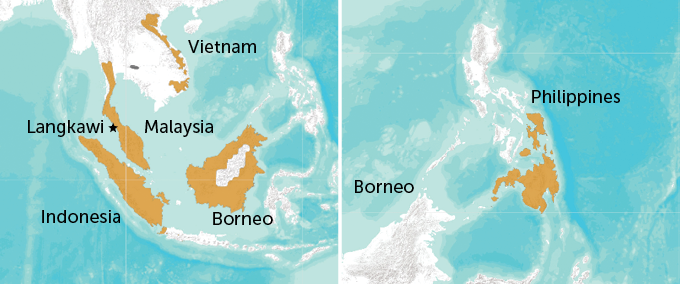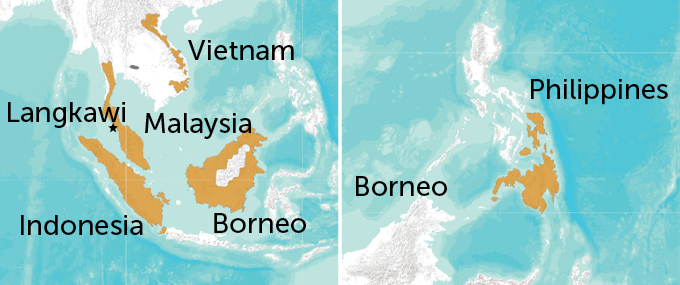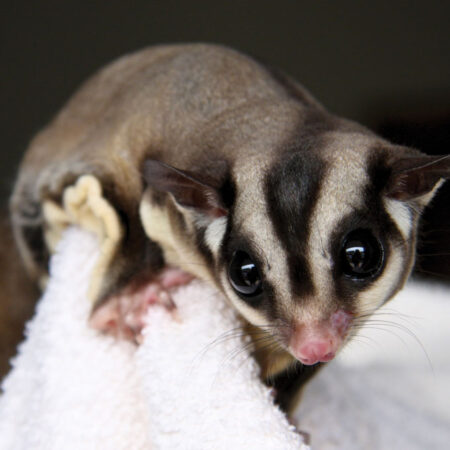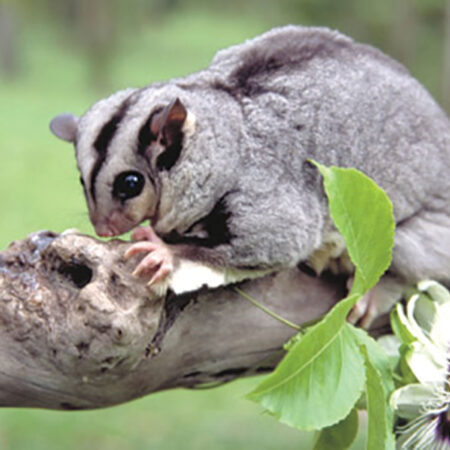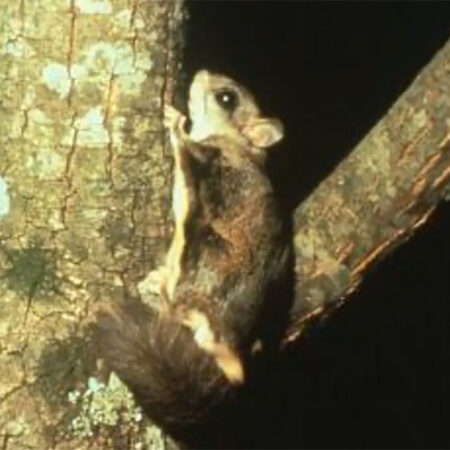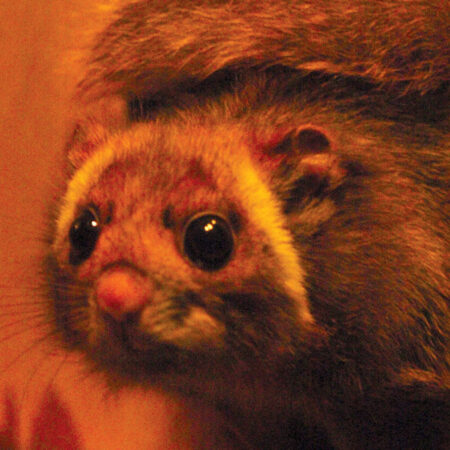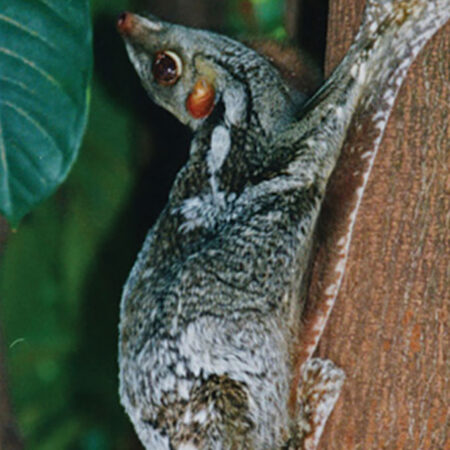This post was originally published on this site
My companions scanned the treetops with binoculars and a thermal-imaging monocular. I stared at the branches and leaves, pretending I knew what to look for. It was a cool June evening just before sunset on a village road on Langkawi Island, Malaysia.
“There’s one! Up there,” one of the biologists called out. I squinted at the spot, about five meters up the tree trunk, and saw only a brown knob speckled with gray. Where? Then the knob stirred. Its top edge rose and turned, and I was staring into a pair of bulging eyes set on a small head with a short snout.
My first colugo. The size of a house cat, colugos are nocturnal mammals that live in trees. Colugos are also called “flying lemurs,” which is a misnomer because they cannot fly and they are not lemurs. A colugo has a cape of skin that stretches from its neck to the tips of its four limbs and tail. That skin, furry on top, helps colugos glide far and hide well in the canopy.
“Wait … Oh, it has a baby!” called zoologist Priscillia Miard of Universiti Sains Malaysia in Penang and leader of that evening’s search. She passed me her binoculars as the team discussed the identity of this colugo.
A tiny head popped out from beneath the mother’s fur, like a child peering out from under a blanket. Baby colugos cling to their mother’s furless undersides until about age 6 months, nursing on nipples near mom’s armpits.
I had seen two colugos just 15 minutes into our search!
The mother colugo lifted her tail. “It’s pooping,” said Miard, without the slightest note of concern that we were standing right below. Miard later told me that colugo feces are like dried lentils — nothing messy.
For an animal that is the closest living relative to all primates, having branched off about 80 million years ago, colugos remain a big mystery (SN: 9/3/16, p. 17). Today, the two living species of colugos are found only in Southeast Asia, though recent studies suggest that two is an imperfect count. Miard and other scientists have begun to upend what little knowledge exists about these mammals, revealing how colugos communicate and how they glide more than the length of a football field.
Into the night
Colugos popped unexpectedly into Miard’s life three years ago. The then 28-year-old French researcher had spent five years in Borneo studying nocturnal primates, including tarsiers and slow lorises. In 2017, Miard visited Langkawi, famous for its beaches and paddy fields, where she saw colugos “everywhere” — in orchards, on golf courses, at resorts and along well-traveled village roads. Because colugos were abundant and easy to find and observe in Langkawi, Miard pivoted to study them. In August, she successfully defended her Ph.D. thesis at Universiti Sains Malaysia for her research on colugo ecology.
But as I stood by her side looking up, Miard did not mention her Ph.D. She focused on the mother colugo — now a few dried lentils lighter — which seemed ready to start her night. The colugo climbed to the far end of a branch and turned her head toward the road. Then she leaped.
The colugo spun around, stretched her legs and tail, and glided like a magic carpet across the road to another tree trunk. Then she hopped, hopped, hopped up the tree into the leaves and out of sight.
She glided to four other trees over the next 15 minutes. By then, Miard and her teammates — biologists Muhammad Fizri bin Ahmad Zubir and Célia Lacomme — had recognized the mother colugo’s fur coloration. They had been following her for some time, naming her “Batwoman” because, months ago, locals thought the researchers were looking into the trees for bats.
Streetlights and passing cars and motorcycles lit the road, but a few meters away, the trees were dark. Miard and Lacomme switched on their red-light head lamps to illuminate the treetops. Something moved on a nearby tree trunk. Another colugo! Miard pointed her camera, saw testicles and announced that the colugo was male.
Master gliders
All colugos are master gliders, considered among the best of the 60-odd species of mammals that can glide. One Sunda colugo (Galeopterus variegatus) was recorded gliding 145 meters, almost the length of three Olympic swimming pools.
That sustained glide was reported in 2011 in the Journal of Experimental Biology by Gregory Byrnes, a biologist at Siena College in Loudonville, N.Y., and colleagues. At the time, most researchers assumed gliding was an energy-efficient way for colugos to travel. Byrnes’ team tested that idea by gluing data loggers onto wild Sunda colugos in Singapore and recording almost 260 glides among four individuals.
Sunda colugos often climb before gliding. In the study, a Sunda colugo could climb a total of 320 meters and glide 1,342 meters in one night. “No one ever took into consideration that in order to glide, you’ve got to climb,” Byrnes says. His team fed colugo data into metabolic models of other tree-dwelling mammals to estimate how much energy colugos expend to both glide and climb. When climbing is included as part of gliding behavior, and in forests where treetops overlap, a colugo could save energy crawling through the canopy rather than gliding, he says.
The “big advantage” of gliding is that it saves colugos time, Byrnes says. Gliding lets an animal cross open space in a few seconds so that it can spend more time feeding or traveling even farther, he says.
Colugos pull off those long-distance glides with their gliding skin, known as a patagium. While other gliders like flying squirrels have a patagium that stretches to the hind feet, a colugo’s patagium continues all the way to the tip of the tail. A more expansive patagium gives a colugo extra “wing area,” which lifts and slows the animal, allowing a gentler descent than other gliders, Byrnes says. The extra skin also helps the animal glide far.
And there is more to the patagium than skin and fur. Byrnes and his collaborators have found that the thin patagium is rich in muscles, and some parts are stiffer than others. A colugo may be able to flex those muscles to change the shape and stiffness of its patagium and thereby adjust its aerodynamics midair. Understanding the gliding biomechanics of colugos might help in the design of robotics and wing technology, Byrnes says.
That evening in Langkawi, Batwoman glided down the road, across the road and up the road. Never a sound. Once, she was gliding straight toward a tree, and just before impact, she turned, cut a sharp arc and landed on the next trunk. Wow.
High talk
When Batwoman reached her fifth tree of the night, another colugo swooped in from the dark and hopped up the trunk toward her.
Colugos were once thought to be solitary animals, Miard says. Social interactions were brief and rarely seen. But newer observations by Miard and others suggest that colugos form loose social groups of females or a mother and her offspring — even those that are weaned. Miard has seen up to six colugos in a tree. Males, though, seem to travel alone, joining groups of females only temporarily.
Miard trained her camera on the newcomer, which passed by Batwoman and continued into the canopy. Not a glance. Miard looked disappointed. “Oh no, he didn’t even say hi.”
To my ear, Batwoman hasn’t made a sound. But she may have been calling in ultrasound, inaudible to humans. Miard and colleagues discovered ultrasound calls from colugos, reporting the finding in 2019 in Bioacoustics. A microphone picked up the ultrasound signals during a bat survey, and Miard tracked the source to colugos. Many nocturnal animals, including bats, tarsiers and slow lorises, communicate in ultrasound, probably to avoid detection by predators. Colugos likely do the same. In November, Miard and colleagues will play the ultrasound calls in the field and listen for colugo responses.
It’s 8:15 p.m., dinnertime. Batwoman crawled into the thick foliage and gingerly pulled some leaves for a sniff. Miard explained that colugos eat mostly leaves. Batwoman shoved some leaves into her mouth and began to chew. Fizri and Lacomme recorded the observations on a behavior checklist on their smartphones.
“Wait, the baby is trying to eat leaves,” said Miard, looking through the binoculars. Lacomme shined her red-light head lamp at Batwoman. The baby colugo reached out from under its mother, tugged a few small leaves and tried to nibble them. Maybe the baby is learning what to eat from its mother, Miard said. It was too dim for me to tell if the baby actually ate the leaves. Lacomme’s red-light head lamp wasn’t bright enough. White light might have offered a better view.
But Miard won’t shine white light on nocturnal mammals. “When we use white light on colugos, they freeze, but not when we use red light,” she told me later. The freezing, she says, is a sign that white light disturbs the nocturnal mammals.
Miard’s concern makes sense. White light, which is commonly used in nocturnal animal studies, can quickly saturate the sensitive optic cells in nocturnal animals’ eyes and cause temporary blindness, says primatologist Amanda Melin of the University of Calgary in Canada. “These moments of blindness are likely disorienting and potentially harmful,” Melin says. “Red light is likely far less disruptive as it will be much lower intensity” than white light.
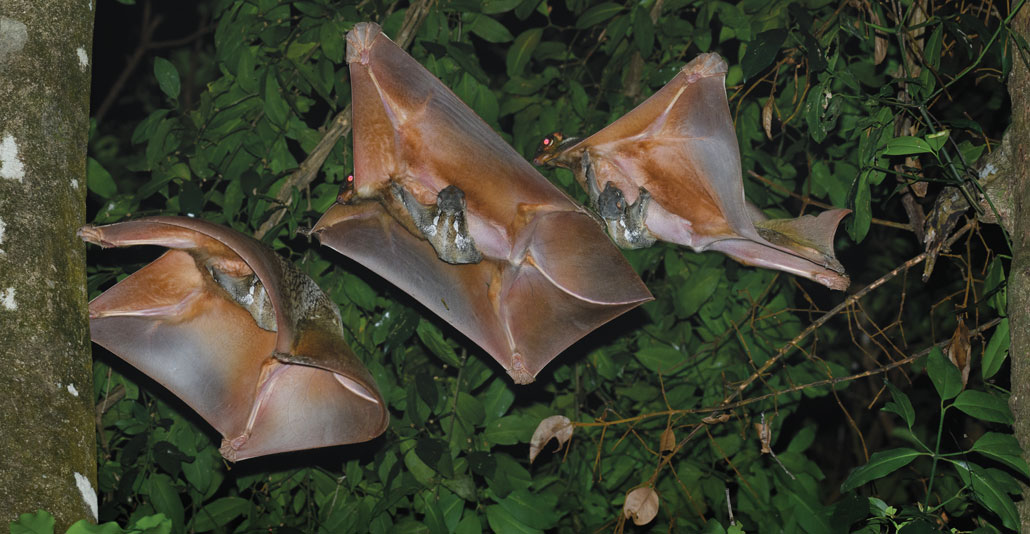
Eager pursuit
Around 9 p.m., another colugo glided in and joined Batwoman on a tree. This one seemed more interested than the last; he poked Batwoman and bit her sides. The newcomer, a male, wanted to mate, Miard said. But every time he got close, Batwoman pulled away.
Miard clutched her camera tight. Colugo romance makes prized footage. Gazing into the canopy, Miard backed away from the tree and onto the road — into the path of an oncoming car that just managed to stop before hitting her.
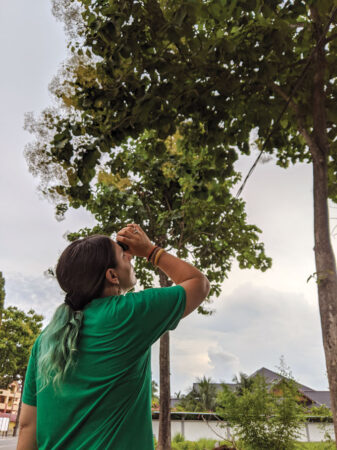
“F—, we are going to miss the most important part. We know they are going to make babies, but I can’t see them,” Miard said. She turned to Fizri: “Where’s the thermal camera?”
Minutes later, Miard spotted the colugos near the top of the tree. “You are really lucky,” she told me. “Many exciting things tonight.”
Batwoman continued to test the male, which I decided to name “Eager.” She glided to another tree, then another and yet another with Eager close behind. The colugos lingered on one tree. Miard sat by the road, camera in hand, eyes on Batwoman.
“Come on guys…. Please let him do it, please … Batwoman,” Miard muttered.
Our small group piqued the curiosity of locals. A couple, standing at the porch of a nearby house, watched us for about 10 minutes, then came over. “It’s a kubong,” Fizri told them, giving the local Malay name for colugo.
The couple knew the name but not the animal. They thought colugos lived only in forests. “Does it eat fruit? Is it like a bat?” they asked in hushed tones. Fizri lowered his smartphone and began to explain colugo ecology. The opportunity to talk colugo with local residents and correct misconceptions is one of the reasons Miard likes to study colugos in villages.
Colugo conservation
Perhaps because they are nocturnal and well camouflaged, colugos live hidden in plain sight. Zoologist Dzulhelmi Nasir, now with the Malaysian Palm Oil Board, has studied colugos in Borneo. Most locals have never heard of colugos, he says. People often confuse the animals with flying squirrels or a giant fruit bat called kluang in Malay.
Confusion or misconceptions about the colugos can be deadly for the animals. In parts of Malaysia, orchard and plantation owners see colugos as fruit pests and kill them, Miard told me. But colugos rarely eat fruits and flowers, according to a study published in 2006 in Biodiversity & Conservation, as well as Miard’s own unpublished research. Fortunately, here in Langkawi, there are few commercial orchards, and locals leave colugos alone.
But across Southeast Asia, colugos are losing their forest homes to agriculture and development. The region lost 293,000 square kilometers of forest from 2000 to 2014, an area about the size of Arizona, according to a 2018 report in Nature Geoscience.
On the International Union for Conservation of Nature’s Red List of Threatened Species, the Sunda colugo and the Philippine colugo (Cynocephalus volans) are categorized as “least concern” for risk of extinction. The Sunda colugo, in particular, with its wide distribution from Vietnam to Indonesia, is unlikely to be threatened.
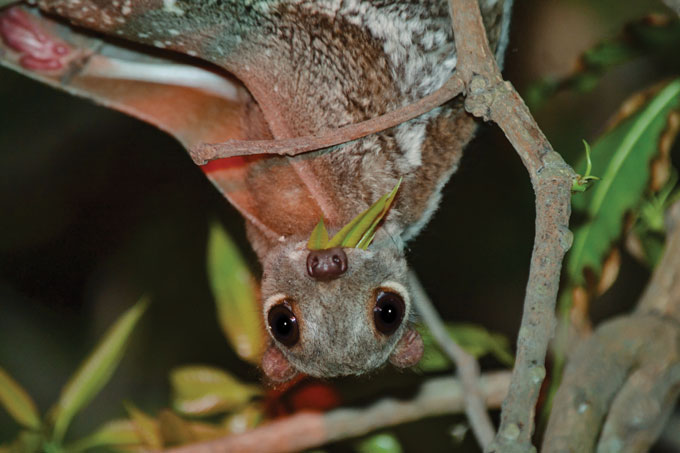
But that assessment might be too rosy. Those two species may actually be eight, or as many as 14, based on genetic evidence reported in 2016 in Science Advances. If so, instead of the Sunda colugo being one widely distributed species, there are several colugo species confined to smaller areas that may be more susceptible to local extinction.
Zoologists had always noted that colugos look different across Southeast Asia. By the 1950s, about 20 species and subspecies were recognized based on physical differences. But zoologists decided to simplify things and lump all subspecies into two species, says geneticist Victor Mason, an author of the 2016 report, who studied colugo phylogeny at Texas A&M University in College Station.
Mason and colleagues looked for signs of species diversity hidden in the genetic makeup of colugos, a task that required samples of colugo DNA from across Southeast Asia. The researchers turned to museum specimens in Singapore and the United States. “There’s hundreds of colugo skulls just sitting in drawers in tiny boxes collecting dust” amassed more than a century ago by European explorers, says Mason, now at the University of Bern’s Institute of Cell Biology in Switzerland.
Using DNA from the museum specimens, Mason and colleagues found up to 14 colugo groups with significant genetic differences. More work is needed to weigh these differences and review the diversity of colugo species. And more surveys of colugo populations and their whereabouts are needed, Miard says, to reliably tell if and where colugos are threatened.
The good news is that colugos appear to adapt well to forested human environments, including the villages in Langkawi. The animals feed on the leaves of five to seven different trees nightly, Dzulhelmi says based on his studies in Langkawi and Borneo. He says that if a township could plant enough trees in gardens, parks and zoos to support free-living colugos, locals could see and learn about the animals and appreciate them.
After 50 minutes of courtship, Eager the male colugo has given up. Batwoman glided back up the road — with four humans on her tail — and began feeding again. We spotted a few more colugos that night, but we stayed close to Batwoman.
Around 11 p.m., Batwoman was still plucking leaves. Suddenly, I felt the air brush my hair — a colugo glided past me to land on a tree about three meters away. I moved in for a closer look at the only colugo I spotted before my guides. But it began to rain, and we ran for shelter.
The next morning, we moved our survey to a leafy resort on the island. In two hours, we found 17 colugos, all hugging trees, motionless in the daylight. I spotted two before Miard did and tried to hide my glee. But the thrill was not mine alone. Soon after we found the 11th colugo, Miard couldn’t hold it in any longer: “I love colugos!”
